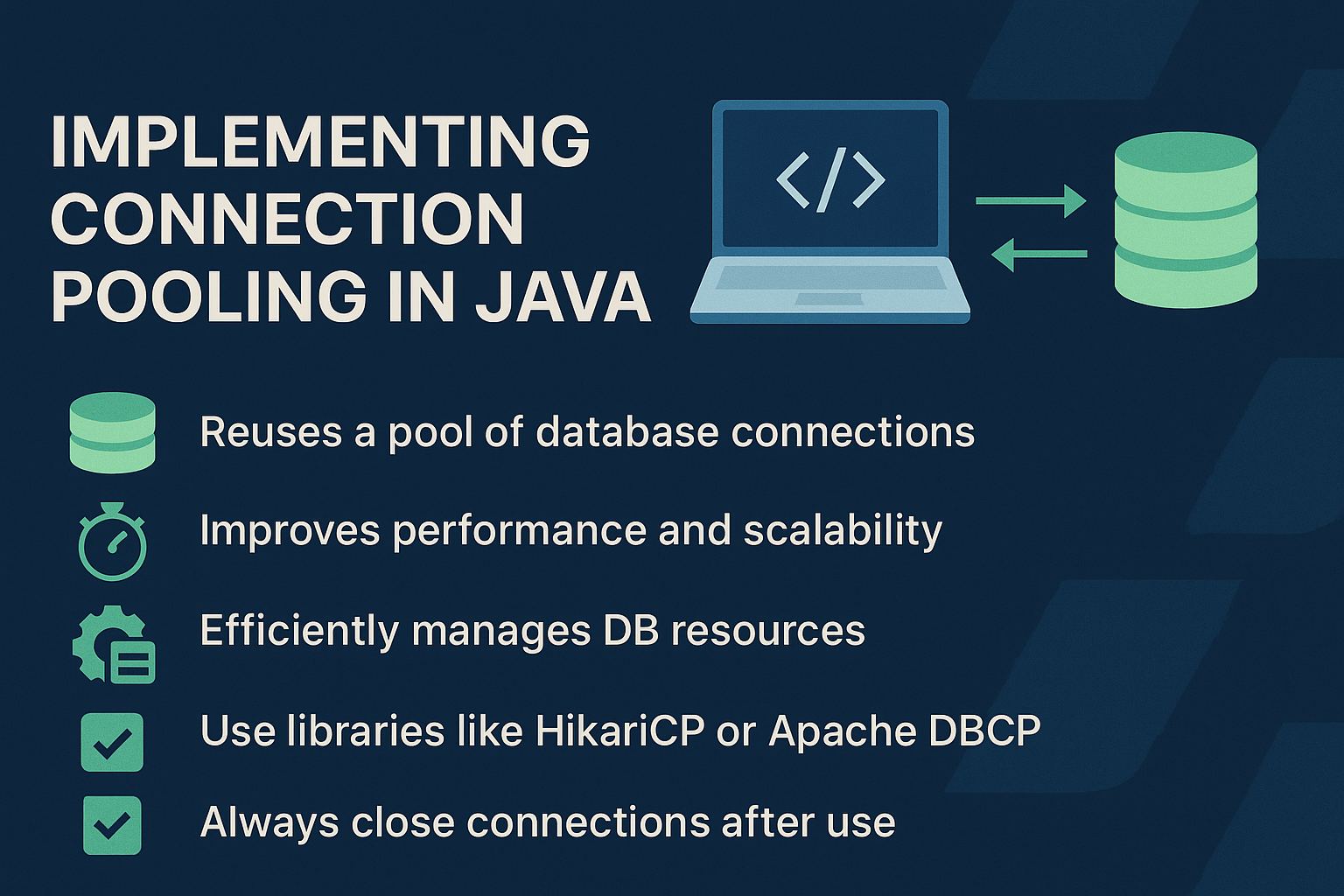Introduction
Connection pooling is a technique used to manage database connections efficiently in Java applications. Instead of creating a new connection for every request, a pool of reusable connections is maintained. This drastically improves performance and scalability for enterprise systems.
Why Connection Pooling Matters
- Performance: Reduces overhead of creating and closing connections.
- Scalability: Handles high-concurrency environments.
- Resource Management: Prevents exhausting database connection limits.
Core Concepts of Connection Pooling
- Connection Pool: A cache of database connections maintained for reuse.
- DataSource: A factory for connections, often used with pooling libraries.
- Max Pool Size: Maximum concurrent connections in the pool.
- Idle Timeout: Closes unused connections to free resources.
Connection Pooling Workflow
Java App → Connection Pool → Database Connections → Database
Real-World Use Cases
- Web Applications: Handling thousands of concurrent requests.
- Microservices: Efficient DB usage across multiple services.
- Enterprise Systems: CRM, ERP, and banking applications.
Implementing Connection Pooling
Example: Using HikariCP (Recommended)
Maven Dependency
<dependency>
<groupId>com.zaxxer</groupId>
<artifactId>HikariCP</artifactId>
<version>5.0.1</version>
</dependency>
Java Code
import com.zaxxer.hikari.HikariConfig;
import com.zaxxer.hikari.HikariDataSource;
import java.sql.*;
public class ConnectionPoolingExample {
private static HikariDataSource dataSource;
static {
HikariConfig config = new HikariConfig();
config.setJdbcUrl("jdbc:mysql://localhost:3306/testdb");
config.setUsername("root");
config.setPassword("password");
config.setMaximumPoolSize(10);
dataSource = new HikariDataSource(config);
}
public static void main(String[] args) {
try (Connection conn = dataSource.getConnection();
PreparedStatement ps = conn.prepareStatement("SELECT id, name FROM employees");
ResultSet rs = ps.executeQuery()) {
while (rs.next()) {
System.out.println(rs.getInt("id") + " - " + rs.getString("name"));
}
} catch (SQLException e) {
e.printStackTrace();
}
}
}
Using Apache DBCP
<dependency>
<groupId>org.apache.commons</groupId>
<artifactId>commons-dbcp2</artifactId>
<version>2.10.0</version>
</dependency>
import org.apache.commons.dbcp2.BasicDataSource;
BasicDataSource ds = new BasicDataSource();
ds.setUrl("jdbc:postgresql://localhost:5432/testdb");
ds.setUsername("postgres");
ds.setPassword("password");
ds.setMaxTotal(10);
Statement vs PreparedStatement vs Pooled Connections
| Feature | Statement | PreparedStatement | Connection Pool |
|---|---|---|---|
| Purpose | Executes SQL queries | Executes parameterized queries | Manages reusable connections |
| SQL Injection Safety | Low | High | Depends on query type |
| Performance | Low (new connection each time) | Medium | High (reuses connections) |
Common Mistakes and Anti-Patterns
- Not closing connections: Even with pooling, always close connections to return them to the pool.
- Over-provisioning pools: Setting max connections too high can overwhelm the database.
- Ignoring PreparedStatements caching: Leads to repeated query compilation.
- Using DriverManager: Use DataSource for pooling instead.
Security Implications
- Use SSL/TLS for secure database connections.
- Store credentials securely in environment variables or secret managers.
- Restrict DB access to trusted IPs.
Performance and Scalability
- Tune pool size based on database and application load.
- Use monitoring tools to track pool performance.
- Combine with batching and PreparedStatements for optimal performance.
Best Practices
- Use HikariCP for high-performance pooling.
- Always close connections in try-with-resources.
- Use connection pools even in small applications for scalability.
- Keep max pool size balanced with DB server capacity.
Real-World Analogy
Think of connection pooling like a taxi stand. Instead of everyone buying a car (new connection), taxis (pooled connections) are reused by passengers (requests), reducing cost and wait time.
Conclusion & Key Takeaways
- Connection pooling is essential for scalable Java applications.
- Use libraries like HikariCP or Apache DBCP.
- Always close connections to return them to the pool.
- Tune pool size for optimal performance.
FAQ
-
What is connection pooling in Java?
A technique to reuse database connections instead of creating a new one for every request. -
Which is the best connection pooling library?
HikariCP is widely regarded as the fastest and most efficient. -
Is connection pooling needed in small apps?
Yes, it improves performance and scalability even for small apps. -
How to return a connection to the pool?
Close it; the pool manages the reuse internally. -
Does Spring Boot use connection pooling?
Yes, it uses HikariCP by default. -
Can I use pooling with PostgreSQL and MySQL?
Yes, all major databases support pooling via JDBC. -
What happens if I don’t close connections?
Connections stay occupied and the pool exhausts quickly. -
Can connection pooling prevent SQL injection?
No, use PreparedStatement for injection prevention. -
What is the default pool size in HikariCP?
Typically 10 connections, configurable viasetMaximumPoolSize(). -
Does connection pooling work with transactions?
Yes, pooled connections fully support transactions.
